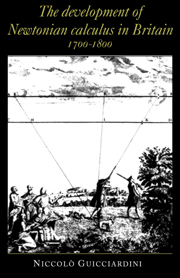Book contents
- Frontmatter
- Contents
- Introduction
- OVERTURE: NEWTON'S PUBLISHED WORK ON THE CALCULUS OF FLUXIONS
- PART I THE EARLY PERIOD
- PART II THE MIDDLE PERIOD
- 4 THE TEXTBOOKS ON FLUXIONS (1736–58)
- 5 SOME APPLICATIONS OF THE CALCULUS (1740–3)
- 6 THE ANALYTIC ART (1755–85)
- PART III THE REFORM
- CONCLUSION
- APPENDIX A TABLES OF CONTENTS OF FLUXIONARY TEXTBOOKS
- APPENDIX B PRICE LIST OF MATHEMATICAL BOOKS PRINTED FOR JOHN NOURSE
- APPENDIX C CHAIRS IN THE UNIVERSITIES
- APPENDIX D MILITARY ACADEMIES
- APPENDIX E SUBJECT INDEX OF PRIMARY LITERATURE
- APPENDIX F MANUSCRIPT SOURCES
- Notes
- Bibliography
- Index
4 - THE TEXTBOOKS ON FLUXIONS (1736–58)
from PART II - THE MIDDLE PERIOD
Published online by Cambridge University Press: 14 September 2009
- Frontmatter
- Contents
- Introduction
- OVERTURE: NEWTON'S PUBLISHED WORK ON THE CALCULUS OF FLUXIONS
- PART I THE EARLY PERIOD
- PART II THE MIDDLE PERIOD
- 4 THE TEXTBOOKS ON FLUXIONS (1736–58)
- 5 SOME APPLICATIONS OF THE CALCULUS (1740–3)
- 6 THE ANALYTIC ART (1755–85)
- PART III THE REFORM
- CONCLUSION
- APPENDIX A TABLES OF CONTENTS OF FLUXIONARY TEXTBOOKS
- APPENDIX B PRICE LIST OF MATHEMATICAL BOOKS PRINTED FOR JOHN NOURSE
- APPENDIX C CHAIRS IN THE UNIVERSITIES
- APPENDIX D MILITARY ACADEMIES
- APPENDIX E SUBJECT INDEX OF PRIMARY LITERATURE
- APPENDIX F MANUSCRIPT SOURCES
- Notes
- Bibliography
- Index
Summary
in the two decades which followed the dispute with Berkeley the calculus of fluxions was given shape in a number of ‘treatises’. We have already looked at the best achievement of this generation of textbooks, Maclaurin (1742). In this chapter I have grouped together the other treatises. The first thing which strikes one about them is their quantity rather than their quality. It has been possible to estimate that from 1736 to 1777 about 18000 copies of treatises on fluxions were sold in Great Britain. This situation contrasts sharply with the first three decades of the century, in which the calculus of fluxions was known to very few mathematicians. It was about the middle of the century that the world of ‘philomaths’ and, perhaps, some students in the military academies and universities began to practise with Newton's dots. The form the calculus would take in the second half of the eighteenth century very much depended upon the period covered in this chapter.
Teaching the algorithm of fluxions
The flood of controversial pamphlets on foundations published in the years 1734–6 (see chapter 3) was followed by an intense production of ‘textbooks’ on the calculus of fluxions. They were intended for beginners, as Hayes (1704), Ditton (1706) and Stone (1730) had been: the reader was introduced to the notation, rules and application of the calculus. The only requisite was a knowledge of algebra (but not of series) and geometry (with or without trigonometry).
- Type
- Chapter
- Information
- Publisher: Cambridge University PressPrint publication year: 1989



